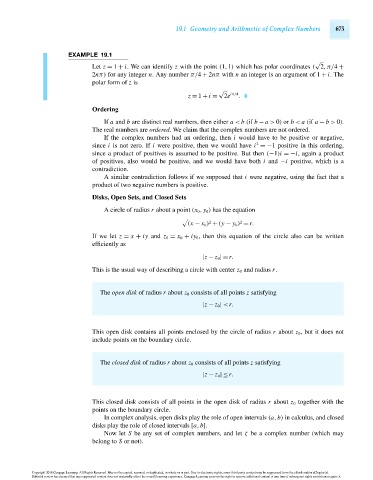Page 693 - Advanced_Engineering_Mathematics o'neil
P. 693
19.1 Geometry and Arithmetic of Complex Numbers 673
EXAMPLE 19.1
√
Let z = 1 + i. We can identify z with the point (1,1) which has polar coordinates ( 2,π/4 +
2nπ) for any integer n. Any number π/4 + 2nπ with n an integer is an argument of 1 + i.The
polar form of z is
√
z = 1 + i = 2e iπ/4 .
Ordering
If a and b are distinct real numbers, then either a < b (if b − a > 0) or b < a (if a − b > 0).
The real numbers are ordered. We claim that the complex numbers are not ordered.
If the complex numbers had an ordering, then i would have to be positive or negative,
2
since i is not zero. If i were positive, then we would have i =−1 positive in this ordering,
since a product of positives is assumed to be positive. But then (−1)i =−i, again a product
of positives, also would be positive, and we would have both i and −i positive, which is a
contradiction.
A similar contradiction follows if we supposed that i were negative, using the fact that a
product of two negative numbers is positive.
Disks, Open Sets, and Closed Sets
A circle of radius r about a point (x 0 , y 0 ) has the equation
2
2
(x − x 0 ) + (y − y 0 ) =r.
If we let z = x + iy and z 0 = x 0 + iy 0 , then this equation of the circle also can be written
efficiently as
|z − z 0 |=r.
This is the usual way of describing a circle with center z 0 and radius r.
The open disk of radius r about z 0 consists of all points z satisfying
|z − z 0 | <r.
This open disk contains all points enclosed by the circle of radius r about z 0 , but it does not
include points on the boundary circle.
The closed disk of radius r about z 0 consists of all points z satisfying
|z − z 0 |≤r.
This closed disk consists of all points in the open disk of radius r about z 0 together with the
points on the boundary circle.
In complex analysis, open disks play the role of open intervals (a,b) in calculus, and closed
disks play the role of closed intervals [a,b].
Now let S be any set of complex numbers, and let ζ be a complex number (which may
belong to S or not).
Copyright 2010 Cengage Learning. All Rights Reserved. May not be copied, scanned, or duplicated, in whole or in part. Due to electronic rights, some third party content may be suppressed from the eBook and/or eChapter(s).
Editorial review has deemed that any suppressed content does not materially affect the overall learning experience. Cengage Learning reserves the right to remove additional content at any time if subsequent rights restrictions require it.
October 15, 2010 18:5 THM/NEIL Page-673 27410_19_ch19_p667-694

